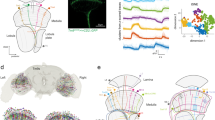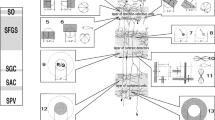Summary
In each compound eye of the fly about 3200 ommatidia are arranged in a peculiarly distorted hexagonal array. Each ommatidium contains 7+1 rhabdomeres arranged in the asymmetrical pattern of the retinula. 7 fibers leaving each ommatidium are distributed onto 7 synaptic sites in the first optic ganglion (lamina ganglionaris), again arranged asymmetrically around the axis of the ommatidium. Taking into account the distortion of the macroscopical array and considering Kirschfeld's findings on the optical properties of the ommatidial lens, this complicated pattern of projection can be explained by the simple principle that all the fibers carrying information from the same point of the optical environment are united into one synaptic site of the lamina ganglionaris.
Similar content being viewed by others
References
Braitenberg, V.: Taxis, Kinesis and Decussation. In: Cybernetics of the Nervous system, vol. XVII, pp. 210–222. Eds. N. Wiener and J.P. Schadé. Progr. Brain Res. Amsterdam-London-New York: Elsevier 1965.
Braitenbrg, V.: Unsymmetrische Projektion der Retinulazellen auf die Lamina ganglionaris bei der Fliege Musca domestica. Z. vergl. Physiol. 50, 212–214 (1966).
—, C. Taddei Ferretti: Landing reaction of Musca Domestica induced by Visual Stimuli. Naturwissenschaften 53, 155 (1966).
Cajal, S., Ramon Y: Histologie du Système Nerveux de l'Homme et des Vertébrés. Paris: Maloine 1911.
—, y D. Sanchez: Contribución al conocimento de los centros nerviosos de los insectos. Trab. Lab. Invest, biol. Univ. Madrid 13, 1–164 (1915).
Dietrich, W.: Die Facettenaugen der Dipteren. Z. wiss. Zool. 92, 465–539 (1909).
Fermi, G., u. W. Reichardt: Optomotorische Reaktionen der Fliege Musca domestica. Kybernetik 2, 15–28 (1963).
Fernández-Morán, H.: Fine structure of the light receptors in the compound eye of insects. Exp. Cell Res., Suppl. 5, 586–644 (1958).
Götz, K. G.: Optomotorische Untersuchung des visuellen Systems einiger Augenmutanten der Fruchtfliege Drosophila. Kybernetik 2, 77–92 (1964).
Goodman, L. J.: The landing responses of insects. 1. The landing response of the fly, Lucilia sericata and other Calliphorinae. J. exp. Biol. 37, 854–878 (1960).
Hassenstein, B.: Ommatidienraster und afferente Bewegungsintegration (Versuche an dem Rüsselkäfer Chlorophanus viridis). Z. vergl. Physiol. 33, 301–326 (1951).
— Die Stärke von optokinetischen Reaktionen auf verschiedene Mustergeschwindigkeiten. Z. Naturforsch. 13, 1–6 (1958a).
— Über die Wahrnehmung der Bewegung von Figuren und unregelmäßigen Helligkeitsmustern. Z. vergl. Physiol. 40, 556–592 (1958b).
— Optokinetische Wirksamkeit bewegter periodischer Muster (Nach Messungen am Rüssel-käfer Chlorophanus viridis). Z. Naturforsch. 14b, 659–689 (1959).
— u. W. Reichardt: Systemtheoretische Analyse der Zeit-, Reihenfolge-und Vorzeichenauswertung bei der Bewegungsperzeption des Rüsselkäfers Chlorophanus. Z. Naturforsch. 11b, 513–524 (1956).
Kirschfeld, K.: Die Beziehung zwischen dem Raster der Ommatidien und dem Raster der Rhabdomere im Komplexauge von Musca. Exp. Brain Res. 3, 248–270 (1967).
McCann, G. D. and G.F. MacGinitie: Optomotor response studies of insect vision. Proc. roy. Soc. B. 163, 369–401 (1965).
Reichardt, W.: Autokorrelationsauswertung als Funktionsprinzip des Zentralnervensystems. Z. Naturforsch. 12b, 448–457 (1957).
— Nervous integration in the facet eye. Biophys. J. 2, 121–143 (1961).
—, u. D. Varjú: Übertragungseigenschaften im Auswertesystem für das Bewegungssehen (Folgerungen aus Experimenten an dem Rüsselkäfer Chlorophanus viridis). Z. Naturforsch. 14b, 674–689 (1959).
Trujillo-Cenóz, O.: Some aspects of the structural organization of the intermediate retina of dipterans. J. Ultrastruct. Res. 13, 1–33 (1965).
Trujillo-Cenóz, O., J. Melamed: Electron microscope observations on the peripheral and intermediate retinas of dipterans. In: The functional organization of the compound eye. Ed. C. G. Bernhard. Pergamon Press 1966 (in print).
Varjú, D.: Optomotorische Reaktionen auf die Bewegung periodischer Helligkeitsmuster. Z. Naturforsch. 14b, 724–735 (1959).
Vowles, D.M.: The receptive fields of cells in the retina of the housefly (Musca domestica). Manuscript.
Author information
Authors and Affiliations
Rights and permissions
About this article
Cite this article
Braitenberg, V. Patterns of projection in the visual system of the fly. I. Retina-lamina projections. Exp Brain Res 3, 271–298 (1967). https://doi.org/10.1007/BF00235589
Received:
Issue Date:
DOI: https://doi.org/10.1007/BF00235589




